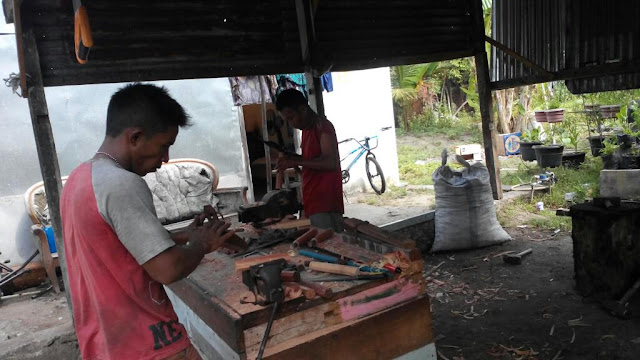Rencong
Rencong is a traditional weapon from Aceh that is made of white metal, brass alloy, and horn of buffalo (white or black). During the colonialism of the Dutch, rencong was used either by men or women in the battle field to battle the Dutch. Rencong is slipped into the scabbard and worn on the left hand side of the stomach directed to the right hand. The way of wearing rencong depicts the egalitarianism, social status, and is also the symbols of self defense, bravery, and heroism in fighting the Dutch. Noted that some great heroes coming from Aceh such as Cut Nyak Dien, Cut Meutia, Pocut Meurah Intan, Pocut Baren and Tengku Fakinah used rencong to fight against the Dutch. They were the silent witnesses of Aceh people‘s bravery in efforts to defend Indonesia, especially Aceh Province from the occupation of the Dutch colonial government.
Nowadays, rencong is a souvenir from Aceh Province. That is why, we suggest you to buy rencong as your souvenir when visiting Aceh Province.
One of the distinctive features of rencong is on its making process. The making process of rencong using white metal as the basic material is rather difficult than using brass alloy. There are four types of rencong in Aceh Province; pudoi, which has not had perfect shape yet on its handle; meukure, decorated with various motifs such as animal, flower, and root; meupocuk, having gold filigree at the upper end of the handle; and meucugek which is on its handle glued something called cugek (a glue and 90 degree of angle).
The Islamic philosophies of rencong are on its handle engraved ba letter (Arabic scripts), as well as on the base of the handle, sin letter. On the bottom of the blade is mim letter while lam letter is along the blade. Those Arabic letters on rencong sound basmalah (in the name of Allah).
Where Find Rencong Home Industry Location
You can find the center of rencong home industries in Baet Masjid Village, Baet Meuseugoe Village, and Baet Lampu ot Village. Those are in the sub-district of Sibreh,
Aceh Besar District, Nangroe Aceh Darussalam Province. It is about 25 km away to reach those three villages from Banda Aceh City by any public transportation for approximately 45 minutes.
Rencong Industry
The price of a rencong depends on its quality, including the material of the blade and the handle and its size as well. For a medium rencong (10-12 cm long) made of brassalloy, the prices range from IDR 20.000 to IDR 75.000. A bigger rencong, more than 12 cm long, vary in price from IDR 75.000 to IDR 80.000. The highest price of rencong is rencong made of white metal as the basic material. Fur currently, there is no guesthouse around those three villages. However, you can observe in more detail its making process. Moreover, you can order a rencong based on what you want. You can choose every material for your Rencong starting from choosing the horn and the material for the blade. Almost all the rencong makers are men. Their knowledge in the making of rencong is inherited from their parents. rencong made by those three villages are distributed to several districts in Aceh Province, especially in the traditional market in Banda Aceh City.


















